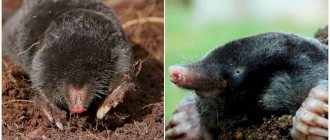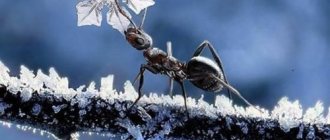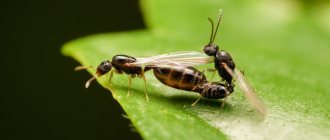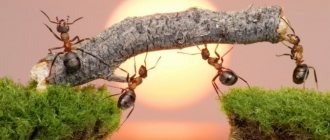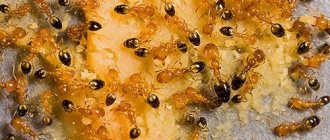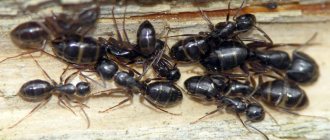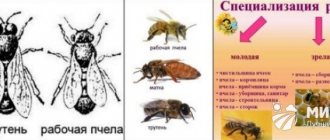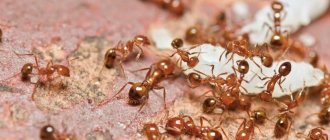The benefits of ants in the garden
Many gardeners and gardeners consider these insects to be harmful. But it is not so. What benefits do ants bring to the soil? By building anthills at a depth of up to one and a half meters, they perfectly loosen the soil, mixing it at a depth of fifty to seventy centimeters. Ants lift soil particles from the lower layers to the surface. Such soil allows air and water to pass through better, nourishing the roots of plants.
If black ants appear on your summer cottage, there is no need to worry about the soil. It is healthy, warmed up, enriched with oxygen, sufficiently moisturized and broken into small lumps. With the help of ants, the decomposition of individual minerals occurs. What benefits do ants bring? The activity of these insects helps remove greenhouse gases. Ants help enrich the soil with humus and minerals such as phosphorus, nitrogen, potassium, magnesium; they reach the plants in a form accessible to them. The area with an anthill located on it is ideal for growing flowers, fruit trees and shrubs.
Ants in the garden
Most gardeners have to deal with ants on their property every now and then, and most often they try to get rid of the insects. However, everything is not so simple.
Benefits for the garden
A garden plot, just like a forest, is an ecosystem - albeit not entirely natural, but partially created by man. Usually, brown meadow and black ants, and less often red forest ants, live in our garden, but they are also capable of performing all the same useful functions there as their forest relatives.
- Ants improve the soil. Firstly, they loosen it in the same way, enriching it with oxygen and mineral salts and helping moisture penetrate deeper, and secondly, they significantly increase fertility by regulating its chemical composition. All nutrients, including fertilizers, are evenly mixed with the soil with the help of ants.
- Ants kill pests. Many garden flies, beetles, slugs and caterpillars are excellent food sources for ants. Cultivated plants, freed from such a scourge, grow and bear fruit better than before. And a person thus gets rid of the need to poison his garden with dangerous chemicals.
- Ants pollinate flowers. In the garden, the role of ants in pollinating berries and fruits is insignificant, however, they also make their contribution.
In some villages, there is also a common belief that ants are especially useful in greenhouses and greenhouses - supposedly they interact with greenhouse gases in some special way, perhaps helping plants absorb more carbon dioxide. However, there are no serious scientific studies to support this assumption.
How to get ants
Usually, ants in a summer cottage start on their own, without outside help. But if you don’t have them in your garden, and you are sure that you want to improve your beds in this way, then you can try introducing insects yourself. There are two main ways.
A more difficult and longer way is to buy a queen with brood and several workers in a special store.
The initial stage of ant breeding - queen and larvae in vitro
You should also stock up on relevant literature on breeding ants in order to handle the insects correctly and so that they do not die. After all, you will need to gradually feed the offspring, move them to an artificial home formicarium filled with soil, and wait until the number of the colony reaches several dozen insects. You can now try to carefully move such an ant family into a hole prepared on the site. True, there are no guarantees that they will take root there. A shorter way is to dig up an anthill in the meadow and try to move it to the garden. Finding an anthill in a meadow is not difficult, but removing it without damaging the queen and offspring is a non-trivial task. Simply digging up part of an anthill, transporting it in a bucket to the site and dumping it in a prepared hole is not a good idea, and if you are not an entomologist, it is better not to even try. Otherwise, you may waste your insect colony. After all, ants are frequent visitors to human sites, and it may be worth just waiting for them to come to you.
Harm to the garden
If you still have a desire to have ants in your garden, think about the risks.
- Ants spoil the roots. If insects have made their nest right in the garden bed, you may soon be missing a few plants, especially when it comes to seedlings. Ants often gnaw on tender shoots and sweet roots, thereby interfering with plant growth. In addition, an anthill may end up on your lawn, flower garden and path, which will damage both the plants themselves and the appearance of the garden.
- Ants spoil trees. In addition to brown, black and red forest ants, wood borers can also appear in the garden. This means that your fruit trees may be in danger, as well as your country house if it is made of logs. If the house has a wood stove, ants can also damage the woodpile.
- Ants breed aphids. The greatest damage from ants is caused not by them themselves, but by their so-called pets - aphids. These small pests suck the juice out of plants, causing them to wither and may even die.
What do ants eat?
What benefits do ants bring? They happily eat caterpillars, worms, and slugs, which cause irreparable harm to plants. Insects inject formic acid into their prey, paralyzing the victim. The diet of ants is not limited to this. It includes fruits and seeds, herbs and juice. But most of all, ants love to feast on the sweet secretions of aphids.
What benefits do ants bring to nature? They destroy intrusive aphids. Ants are associated with these insects by food symbiosis: they transfer aphids from one plant to another. At this time, they themselves are nearby and protect the “herd” of aphids from attacks by flies, lacewings, and beetles. This is how ants store food for the winter.
How are ants useful for humans in the garden?
Forest orderlies benefit the ecosystem and are a link in the food chain. Ants are endowed with the ability to clear the territory of debris, pollinate flowers, and aerate the earth. The beneficial properties of ants for a summer cottage are undeniable.
The main diet of protein ants in gardens and vegetable gardens is harmful insects. One nest can destroy up to two thousand different types of insects - larvae, eggs, midges, caterpillars, mites, beetles. They eat more in one area per day than birds.
Ants provide food for birds, which in turn protects crops from bird attacks. Formic acid is a medicine for them. Birds allow ants to crawl under their wings, then crush the insects with their feathers until formic acid is released.
Soil improvement
At this point, the benefits of ants are the most important; thanks to their assistance, plants grow better and productivity increases.
- by digging passages in the anthill, insects saturate the soil with oxygen, the passages help to quickly moisten it;
- stocking up for the winter, ants bring leaves, remains of small insects, waste products, thereby fertilizing the earth with organic matter and humus;
- the content of phosphorus and potassium in the soil increases, ants contribute to the transition of insoluble elements into a form conveniently consumed by plants - soluble.
Thanks to the forest orderlies, who, stocking up for the winter, collect everything that is suitable for food in their anthills, plant seeds also end up there. Thus, the seeds are distributed throughout the entire territory next to the anthill within a radius of one hundred meters. There are plants that germinate only with the help of ants.
The damage caused by ants in the garden is significant.
Monitor the number of anthills and ants.
Fast reproduction
A small number of anthills in the garden or vegetable garden is beneficial for the site. But as soon as the number increases, and good conditions only contribute to growth, it is necessary to sound the alarm. The ants will begin to feed on everything that the voracious insects get on the road.
The first to suffer are the berries - strawberries and wild strawberries, because these crops ripen close to the ground. Ants will also be attracted to currant and gooseberry bushes. The damage of insects will also be obvious for fruit trees - pears, apple trees, plums.
When digging nest tunnels, ants remove all obstacles from the path. These are mainly the roots of plants and bushes. Planted seeds and newly grown seedlings suffer. Therefore, it is so important to monitor the number of anthills in your garden so that the plant world is not in danger.
Weed control is carried out precisely because ants spread not only useful seeds, but also unnecessary ones on the site. Ants are also capable of growing mushrooms and spreading fungal spores and scabs. Potatoes and some types of fruit trees suffer, which has a bad effect on yields.
Ornamental plants suffer. Especially sweet varieties of flowers - peonies, roses. Ants eat up unopened buds and nibble flower petals. After this, they may not open at all or will be deformed. Most often, insects settle on lawns and clubs. Since flower beds are not weeded as often as noble crops, anthills grow quickly. Even if the visible part of the ant house is not very large, it can be up to 1.5 meters deep.
Due to the huge number of ant tunnels, the thermoregulation of the earth is disrupted. Fertilizers interact with the soil incorrectly and are poorly absorbed. The acidity of the soil increases, which has a good effect on increasing the number of ants. It will not be possible to grow a full-fledged crop in such an acidic environment.
Breeding aphids
Ants breed aphids and graze them, like people do cows. Insects transfer them from an eaten plant to a new one, reducing the quantity and quality of the harvest, and hide the aphids in nests for the winter. Aphids feed on the sap and green tender parts of plants, preferring the amino acids contained there. The secretions formed on the bodies of aphids are called honeydew. Ants store it for the winter and use it to feed their large tribe.
In winter, ants hibernate or move to warm residential buildings. There are even more opportunities for living in such conditions than on the street. There is an abundance of food and food waste, the anthill is located so that it cannot be immediately found. Such conditions increase the number of individuals.
Ants are amazing creatures with a complex social structure. Scientists believe that these insects have intelligence. In nature, they occupy their ecological niche, performing important functions.
In the forest
Many people have heard that forest anthills should not be destroyed. This is true, and it’s not for nothing that ants are called forest orderlies - they bring invaluable help to the forest.
Red ants are most often found in Russian forests
- They eat harmful insects along with birds, but do it 20 times faster than birds. In one summer, the inhabitants of one anthill are capable of destroying several million pests.
- Promote the spread of plants: when ants drag the found seeds into their home as food, some of them are lost and thus the plants colonize new territories.
- Little workers not only distribute seeds, but also pollinate plants by feeding on flower nectar.
- Ants are an important link in the food chain of forest inhabitants, as they provide food for many birds.
- Sometimes ants settle in dead trees, helping them decompose, thereby clearing the forest of rotten, rotten, diseased specimens.
- Ants improve the soil. By trampling paths and building the lower levels of anthills, they are able to loosen the ground to a depth of up to half a meter, fertilizing and aerating it. This is why plants near anthills develop well - fertilized soil helps them.
Birds use ants not only as food, but also as medicine - to destroy body parasites, they “bathe” in anthills.
In the garden
Gardeners do not like ants, considering them pests of the site. This is partly true, because they protect and breed aphids, and can also damage plant roots. But there are benefits from little workers:
- Black garden ants, like forest ants, loosen the soil well. In the process, insects mix it with grass, humus, and animal remains. As a result, the earth is saturated with oxygen, nitrogen, minerals and organic substances.
- Ants are the enemies of insect pests (with the exception of aphids). They especially like to hunt caterpillars of ringed silkworms and apple moths.
When the prey is too large, the ants attack together: some can hold the caterpillar, while others inject poison into it
In fact, ants cause direct harm to plants only by settling in the beds, so if their numbers have not become excessive and the fruits are not suffering, there is no need to rush to destroy natural assistants in pest control. And to cope with aphids, first of all you need to fight them, and not the ants.
Garden ants are mainly dangerous for berries.
For people
In addition to the benefits for the forest and garden, ants also bring benefits to humans. They are used to produce formic alcohol and other preparations based on formic acid.
Preparations based on formic acid are used in the treatment of:
- arthritis;
- neuroses;
- senile dizziness;
- hepatitis A;
- purulent skin lesions;
- Medicines with a hemostatic effect are also made from ants.
Sometimes live ants are used for treatment, allowing them to bite diseased parts of the body. However, this folk method requires great caution, because some people have severe allergic reactions to ant venom.
Formic acid has other applications:
- in surgery and pharmaceuticals it is used for disinfection as part of “pervomura” (a mixture of formic alcohol and hydrogen peroxide);
- when preparing agricultural feed (hay and silage), it is used as a preservative and antibacterial additive;
- used in beekeeping to combat parasites;
- sometimes used in wool dyeing.
House pharaoh ants emit substances that are harmful to house bugs
Some people find use for ants in everyday life, using them to rid their indoor plants of pests. It is worth noting that it is better to use forest ants for these purposes. Pets that spoil food and chew furniture are not particularly beneficial.
Why ants are useful:
- Have a positive effect on the soil;
- They serve as a source of food for many forest and game birds, which include woodpeckers, tits, black grouse, wood grouse;
- Contribute to an increase in forest grass cover and its enrichment;
- They control populations of harmful insects - they eat a species that has begun to reproduce en masse. By switching entirely to one species, they do not allow it to spread in the future.
REFERENCE: Due to the loosening of the soil by ants, it is enriched with oxygen and nutrients, increasing biological activity.
What harm do:
- In the habitats of ants, the acidity of the soil is increased, which has an adverse effect on the nutrition and growth of plants;
- Constructed anthills in garden shrubs and plants do not allow them to fully grow and develop;
- When the numbers are quite large, they begin to eat garden berries, vegetables and root vegetables;
- When collecting nectar from peony buds, sepals and petals are gnawed to enhance the secreted juice. This leads to drying of the buds;
- Contribute to the destruction of seedlings and seeds;
REFERENCE: The ant family is capable of eating approximately 10,000 seeds in one season.
- Spread weeds around the garden plot;
- They breed and graze aphids, which cause damage to plants and trees.
What is useful in the garden and vegetable garden:
- By building an anthill at a depth of one and a half meters, they help loosen and mix the soil. They raise particles of the lower layers to the surface, making the soil loose, perfectly permeable to air and moisture. The root system of the plant receives a lot of nutrition;
- Due to the removal of greenhouse gases from the soil by ants, its nutritional value increases. It is enriched with minerals, the potassium content increases twofold, phosphorus tenfold. The area above the anthill is ideal for growing all garden crops;
- Get rid of garden parasites: caterpillars, worms, slugs.
- They feed on harmful insects and caterpillars. In a day, residents of just one small anthill can eat tens of times more harmful insects than a bird.
- Moving among the flowers, they pollinate them.
- They loosen the soil quite actively. Penetrating 0.5 meters deep, they mix the soil well with all kinds of blades of grass, leaves and other woody and herbaceous structures. Insect remains also act as soil fertilizers. The soil is saturated with useful minerals and organic matter.
- By loosening the soil, ants saturate it with oxygen. It has been noticed that plants grow much better when located near an ant heap. The soil becomes more fertile. If earthworms are able to penetrate no more than 20 cm deep, then ants can build an entire city underground in two years at a depth of up to 1.5 meters. Nutrients and water penetrate there. The roots of the plants feel great at the same time.
- A medium-sized anthill will save the garden from 2 thousand individuals of harmful insects and larvae in 1 day.
- Ants provide food for birds and some animals. And not just food! A bird enters an anthill, the ants, crawling under the feathers, rid it of parasites, and formic acid can even treat birds from diseases.
- The presence of ants improves the composition of the soil - the potassium content doubles and the phosphorus content increases 10 times. Thanks to the soluble form, potassium and phosphorus become more absorbable by plants.
- In places where ants live, the acidity of the soil increases, and plants develop poorly.
- They gnaw at sweet fruits and berries—strawberries and wild strawberries are the first to suffer.
- They eat the sweet petals of flower buds, which spoils them and prevents them from blooming to their full potential.
- They spread weed seeds.
- In addition to aphids, ants breed some types of caterpillars, cicadas and other pests.
- They gnaw out the sown seeds.
- They gnaw the roots of plants.
- They breed aphids.
The role of food for ants
The food of insects is a significant factor in their “political” life. It plays the role of uniting ants into a single mechanism of natural society. An ant will never eat its prey secretly from its relatives. He will run to the anthill and transfer food to his fellow colony member. The ant shares its prey with other inhabitants of the family and feeds the larvae. This food is enough for about a hundred individuals. The enzymes in its composition serve as a variety of signals.
The anthill is “heated” with food. At the beginning of spring, to prevent the young animals from dying, it is necessary to raise the temperature in the places where they accumulate. What benefits do ants bring to prevent the death of the larvae? They are grouped into balls. At this time of year, carbohydrates that come from food stored for the winter are intensively oxidized in their bodies. This process is accompanied by the release of heat.
Ants are small guardians of the forest
But not all insects harm the environment. There are those who strive to protect it from pests with all their might. Everyone has heard about them, and yet not many know why ants are forest nurses.
It's actually quite simple. Ants destroy almost all insects that dare to crawl into their territory. At the same time, they can easily cope with an enemy that surpasses them both in size and physical strength. And all because ants are a team capable of acting as one mechanism.
In addition, they use small garbage in their construction, thereby cleaning the forest. According to experts, five anthills are enough to keep an area of one hectare clean.
How are ants useful in the forest?
People often underestimate ants, considering them useless. But this is not at all true, Ants are the most useful inhabitants of the forest. When talking about these insects, one should remember about their collecting and predatory activities. Having settled in wood that has died for some reason, ants contribute to its mechanical destruction. They crawl around the area around the nest for a reason.
Ants are constantly searching for wood and grass particles: twigs, pine needles, scales, blades of grass and other forest debris. They take all this to the anthill. Here these particles decompose much faster than on any surface. Along with them, dead wood begins to rot and decompose. A forest is not a summer cottage, and it is simply impossible to manually clear it of all rubbish. This is what the ants do. It’s not for nothing that they are called forest orderlies.
So what benefit do ants bring to the forest? They clear it of diseased, rotten and destroyed trees. In the forest it is impossible to find large concentrations of harmful insects in the habitats of ants. For reference: the population of a two-meter-high anthill successfully fights against harmful insects in a forest area exceeding one hectare. There are forests where ants are introduced artificially.
What benefits do ants bring? They help increase the biological activity of the soil, enriching it with oxygen and substances useful for plant growth. The ants themselves provide food for many birds, such as woodpeckers, tits, wood grouse, and black grouse. Birds also love to take “ant baths.” They “dive” into the anthill and tuck its inhabitants under their wings. In this way, birds are freed from parasites.
Benefits in nature
It’s not for nothing that the ant is called the forest orderly. It accelerates the decomposition of rotten wood, collects dry leaves and branches, and cleans plants of caterpillars, mites, and sawflies. The insect may cause harm, but it also performs many useful functions.
Benefits in soil formation
Arthropods loosen the soil better than worms. They dig holes at a depth of 70 cm, while worms do not penetrate the soil below 20 cm. The soil is mixed and enriched with the following substances:
- humus;
- nitrogen;
- potassium;
- phosphorus;
- magnesium.
This improves the growth and development of plants. You may notice that the vegetation around anthills is denser and healthier.
On a note!
Few people know why ants are needed in the forest and fields. But their benefits here are invaluable - they are the ones who loosen the earth, filling it with air and nutrients.
A lot of excrement accumulates around anthills, which serves as fertilizer for vegetation.
Benefits in clearing forests
Benefits of Ants
Rotten stumps become a haven for ants. They build a nest there and speed up the decomposition process of the dead tree. Forest ants, during the construction of their home, collect leaves, branches, blades of grass and pine needles from the surrounding area.
Interesting!
In an anthill, the decomposition of grass and wood particles occurs faster than in air. This is due to the fact that there is higher temperature and humidity, as well as a unique microflora with its own bacteria and fungi.
Benefits for plants
The benefits of ants in nature are enormous. They spread seeds throughout the forest. About 3,000 plant species are spread by industrious insects. Including:
- fragrant violet;
- celandine;
- goose onion;
- corydalis;
- thyme;
- hairy hairy
All these herbs and flowers cannot grow without ants, who carry their seeds into the house, losing some along the way.
The following plants are carried exclusively by ants:
- violet;
- hoof;
- woodland and other myrmecochoreous plants.
Some types of ants love to feed on sweet pollen and thus can help pollinate flowers.
Benefits in pest control
Pest control
Arthropods clear the forest of dead insects and pests. It is known that moths and sawflies destroy plants and thereby cause enormous harm to the forest. But where there is an anthill, the number of these pests is small.
On a note!
If there are few ants in the forest, then foresters specially populate these beneficial insects. One anthill per day can clear the surrounding area of 2000 larvae and pupae of various pests.
Link in the food chain
Here, too, there is no benefit from ants. Songbirds and some animals hunt insects:
- badgers;
- foxes;
- hazel grouse;
- the Bears.
Birds love to bathe their feathers in ants. In this way they get rid of pests. Some scientists are sure that birds are also treated with ants, crushing them under their wings. After all, formic acid benefits the body.
What benefits do ants bring to people?
Even in ancient times, people knew about the beneficial properties of formic alcohol, which is secreted by insects. Today, modern medicine uses this gift of nature for medicinal purposes. What benefits do ants bring to humans? Medicines are produced based on formic alcohol.
They treat diseases such as tuberculosis, bronchial asthma, hepatitis, kidney failure, and diabetes. In folk medicine, tinctures are prepared from live and dried forest ants, which are used to treat neuralgia and many joint diseases. Insects are collected in mid-summer. Red ants are suitable for medicine.
A little about toads
When cultivating a plot of land, you can often see clumsy toads slowly crawling to the side. Many people, unfortunately, are disgusted by them. But toads, tirelessly exterminating harmful insects, bring benefits to gardens and vegetable gardens. Toads are amphibians. Some of their species, becoming adults, live and get their food exclusively on the ground. The most common are gray or common toads and green amphibians with large spots of the same color. The toad's body is covered with numerous warts.
Amphibian Nutrient Environment
Toads eat animal food: harmful insects, beetles, bedbugs, ants. Their menu doesn't stop there. They eat pests such as mole crickets, wireworms, weevils, Colorado potato beetle larvae, and caterpillars with great appetite. Young toads are not aggressive; they are quite happy with every little thing: aphids, mosquitoes, crimson beetles and weevils. During the day, one adult eats about eight grams of insects.
What benefits do ants and toads bring? Amphibians destroy two to three times more pests than insectivorous birds. They do not refuse parasites with a bad smell and bad taste, which birds disdain. Toads are better at hunting pests whose body color blends with the natural background. Birds sleep at night, and amphibians hunt at this time. Their prey is insects that lead a nocturnal life: cutworm butterflies, caterpillars, moths, slugs.
The role of birds in the forest ecosystem
By nature, all birds are forest nurses. This is due to the fact that they feed on insects, which, in turn, are the main pests. Judge for yourself, because it is insects that eat tree leaves, destroy wood and bark, and also carry various infectious diseases.
By eating beetles and caterpillars, birds reduce their numbers, which reduces damage to the environment to a minimum. Such a food chain allows us to achieve harmony, which is so necessary for the normal growth of the forest.
Although all birds are forest orderlies, there are still species that do their job better than anyone else. For example:
- The woodpecker is the main doctor in the forest, because it is able to pick out pests straight from the tree trunk. In addition, by knocking on it with his beak, he forces insects to crawl out of the shelter, thereby making them vulnerable to other hunters.
- The pink starling actively hunts locusts. That is why this bird is such a welcome guest not only in forests, but also in orchards.
- Starlings are the fastest forest orderlies. According to rough estimates by scientists, they can catch up to 400 bugs in one day.
